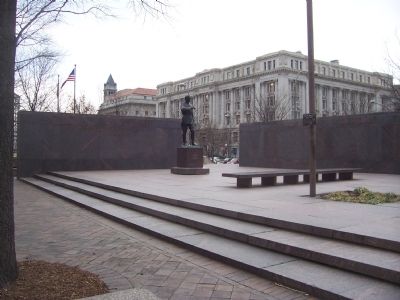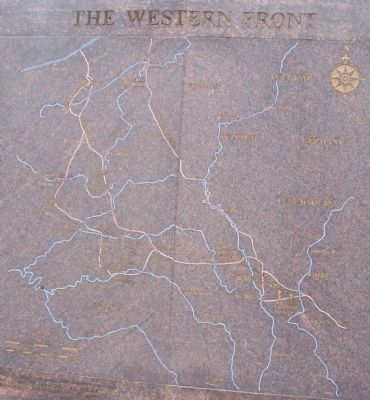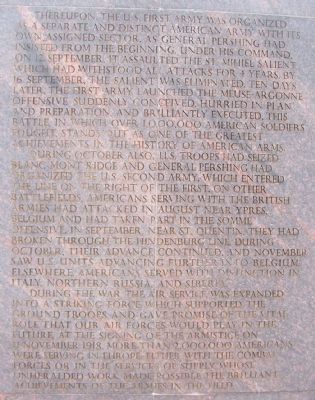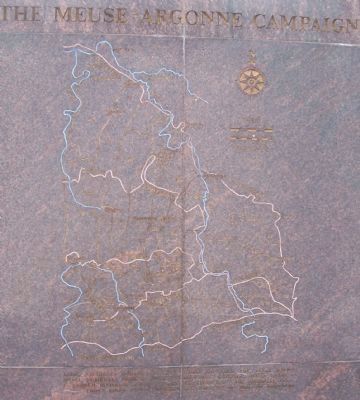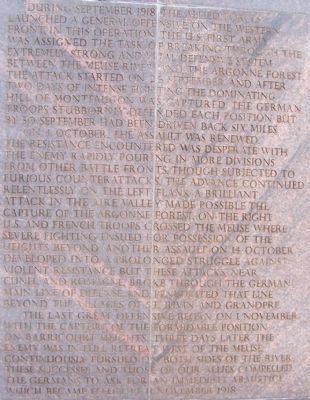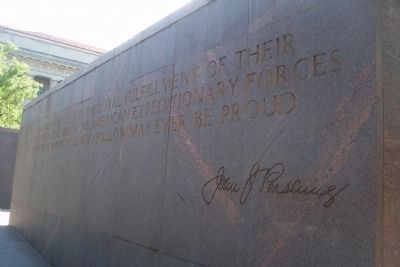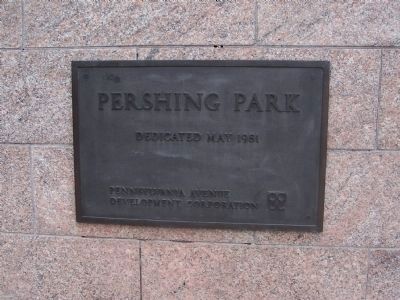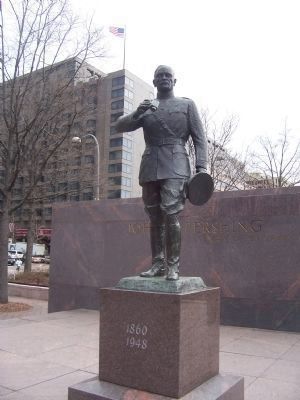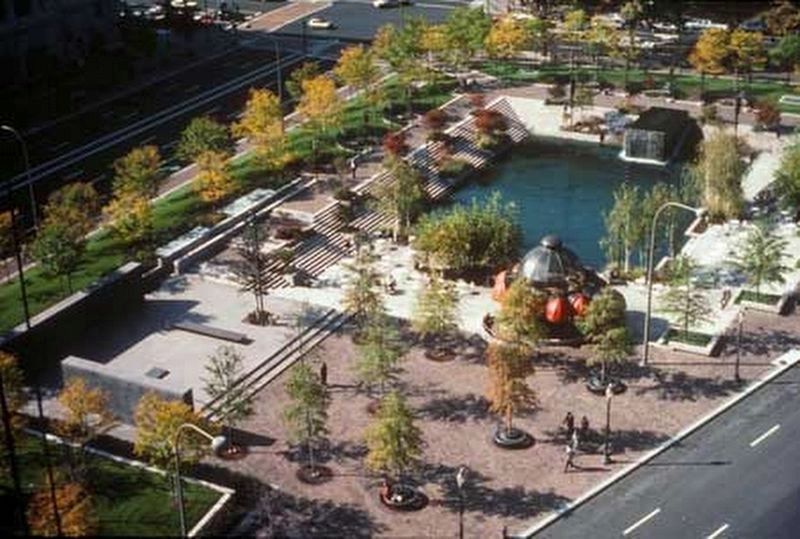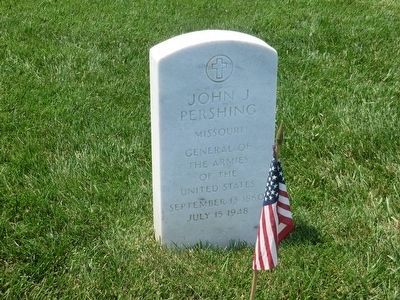Federal Triangle in Northwest Washington in Washington, District of Columbia — The American Northeast (Mid-Atlantic)
John J. Pershing, General of the Armies (1860-1948)
The Western Front - The Meuse-Argonne Campaign
Inscription.
[Panel 1]:
On 6 April 1917, the United States entered World War I. With few regular forces, the task of training and transporting an effective army to fight in France was formidable. The U.S. Navy, acting swiftly to combat the German submarine menace, dispatched fighting ships and aircraft to European waters. Simultaneously, it began the organization of convoys for hundreds of thousands of troops to undertake the tremendous work of organizing the American Expeditionary Forces. General Pershing landed in France on 13 June 1917.
Beginning on 21 March 1918, the German armies launched a series of powerful attacks on the Western Front. On that date there were only 300,000 American soldiers in France, most of them but partially trained. The first offensive action by a U.S. Division came on 28 May when Cantigny was attacked and held despite violent enemy reaction.
Simultaneously, the Germans surged across the Aisne River and advanced rapidly toward the Marne. U.S. reinforcements, hurriedly brought into positions directly across the German path of advance toward Paris, stopped the attack. Then, on 6 June, U.S. troops, including a brigade of Marines, struck back, and in fierce combat lasting a month, recaptured Belleau Wood and the town of Vaux. The last great German offensive of the war came on 15 July along the Marne, east of Chateau-Thierry. It was promptly repulsed in a severe struggle in which American troops played a leading part. The immediate U.S. - French counter attack on 18 July at Soissons marked the turning point of the war.
[Panel 2 - map]:
The Western Front
[Panel 3]:
Thereupon, the U.S. First Army was organized as a separate and distinct American Army with its own assigned sector, as General Pershing had insisted from the beginning. Under his command, on 12 September, it assaulted the St. Mihiel salient which had withstood all attacks for 4 years. By 16 September, the salient was eliminated. Ten days later, the First Army launched the Meuse-Argonne offensive. Suddenly conceived, hurried in plan and preparation, and brilliantly executed, this battle, in which over 1,000,000 American soldiers fought, stands out as one of the greatest achievements in the history of American arms.
During October also, U.S. troops had seized Blanc Mont Ridge; and General Pershing had organized the U.S. Second Army, which entered the line on the right of the First. On other battlefields, Americans serving with the British armies had attacked in August near Ypres, Belgium and had taken part in the Somme offensive. In September, near St. Quentin, they had broken through the Hindenburg Line. During October, their advance continued, and November saw U.S. units advancing further into Belgium. Elsewhere, Americans served with distinction in Italy, Northern Russia, and Siberia.
During the war, the Air Service was expanded into a striking force which supported the ground troops and gave promise of the vital role that our air forces would play in the future. At the signing of the armistice on 11 November 1918, more than 2,000,000 Americans were serving in Europe, either with the combat forces or in the Services of Supply whose unheralded work made possible the brilliant achievements of the armies in the field.
[Panel 4 - map]:
The Meuse-Argonne Campaign
[Panel 5]:
During September 1918, the Allied Forces launched a general offensive on the Western Front. In this operation, the U.S. First Army was assigned the task of breaking through the extremely strong and vital defensive system between the Meuse River and the Argonne Forest. The attack started on 26 September, and after two days of intense fighting, the dominating hill of Montfaugon was captured. The German troops stubbornly defended each position, but by 30 September had been driven back six miles.
On 4 October, the assault was renewed. The resistance encountered was desperate, with the enemy rapidly pouring in more divisions from other battle fronts. Though subjected to furious counter attacks, the advance continued relentlessly. On the left flank, a brilliant attack in the Aire Valley made possible the capture of the Argonne Forest. On the right, U.S. and French troops crossed the Meuse where severe fighting ensued for possession of the heights beyond. Another assault on 14 October developed into a prolonged struggle against violent resistance; but these attacks, near Cunel and Romagne, broke through the German main line of defense and penetrated that line beyond the villages of St. Juvin and Grandpre.
The last great offensive began on 1 November with the capture of the formidable position on Barricourt Heights. Three days later, the enemy was in full retreat west of the Meuse. Continuously pursued on both sides of the river, these successes and those of our allies compelled the Germans to ask for an immediate armistice which became effective 11 November 1918.
[Panel 6]:
"In their devotion, their valor, and in the loyal fulfillment of their obligations, the officers and men of the American Expeditionary Force have left a heritage of which those who follow may ever be proud," John J. Pershing.
Erected 1981 by Pennsylvania Avenue Development Corporation.
Topics. This historical marker is listed in this topic list: War, World I. A significant historical date for this entry is March 21, 1918.
Location. 38° 53.752′ N, 77° 1.946′ W. Marker is in Northwest Washington in Washington, District of Columbia. It is in Federal Triangle. Marker is at the intersection of Pennsylvania Avenue Northwest and 14th Street Northwest (U.S. 1), in the median on Pennsylvania Avenue Northwest. The inscribed panels adorn the memorial in Pershing Park which forms an island across 14th Street Northwest from "Freedom Plaza" and opposite the Willard International Hotel on the north side of Pennsylvania Avenue Northwest. Touch for map. Marker is at or near this postal address: 1401 Pennsylvania Avenue Northwest, Washington DC 20004, United States of America. Touch for directions.
Other nearby markers. At least 8 other markers are within walking distance of this marker. World War I Memorial (within shouting distance of this marker); World War I, 1914-1917 (within shouting distance of this marker); Beyond the AEF (within shouting distance of this marker); The AEF in the Great War, 1917-1918 (within shouting distance of this marker); From Homefront to Battlefront (within shouting distance of this marker); Americans All (within shouting distance of this marker); A Soldier's Journey (within shouting distance of this marker); Armistice and Legacy (within shouting distance of this marker). Touch for a list and map of all markers in Northwest Washington.
More about this marker. This monument in Pershing Park is the principal memorial to the "Great War" in Washington, D.C. Interestingly, the official "National World War I Memorial of the United States" is located in Kansas City, Missouri. Dedicated in 1926, that recently renovated National Landmark is also known as the "Liberty Memorial."
Though the panels in Pershing Park provide a more informative historical narrative than do those of the grandiose National World War II Memorial (located less than a mile to the southwest and dedicated in 2004), the events they describe (like the monuments to the First World War themselves) now seem almost totally overshadowed in the public's consciousness by those of conflicts in earlier as well as later eras.
Virtually alone among all the outdoor monuments in the Washington area, Pershing Park is not a listed component of the National Park System.
Also see . . .
1. Pershing Park. (Submitted on April 23, 2008, by Richard E. Miller of Oxon Hill, Maryland.)
2. Liberty Memorial, Kansas City, Mo. The National World War I Memorial of the U.S. (Submitted on April 23, 2008, by Richard E. Miller of Oxon Hill, Maryland.)
3. John J. Pershing. (Submitted on April 24, 2008, by Richard E. Miller of Oxon Hill, Maryland.)
Additional keywords. A.E.F.
Credits. This page was last revised on January 30, 2023. It was originally submitted on April 23, 2008, by Richard E. Miller of Oxon Hill, Maryland. This page has been viewed 5,671 times since then and 40 times this year. Last updated on April 8, 2010, by Richard E. Miller of Oxon Hill, Maryland. Photos: 1, 2, 3, 4, 5, 6. submitted on April 23, 2008, by Richard E. Miller of Oxon Hill, Maryland. 7. submitted on August 27, 2008, by Richard E. Miller of Oxon Hill, Maryland. 8, 9. submitted on April 23, 2008, by Richard E. Miller of Oxon Hill, Maryland. 10. submitted on September 17, 2016, by J. J. Prats of Powell, Ohio. 11. submitted on June 12, 2016, by Don Morfe of Baltimore, Maryland. • Kevin W. was the editor who published this page.
